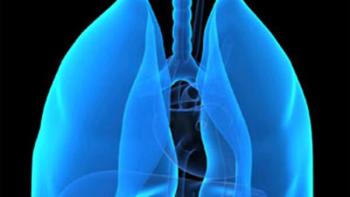
- Summer 2015
- Volume 14
- Issue 3
Delayed Reaction
Pneumonitis, a lung inflammation, often appears months after the cancer treatment that sparked it.
Pneumonitis, a noninfectious inflammation of the lungs, is a side effect associated with several cancer treatments, including radiation and chemotherapy as well as newer targeted drugs and immunotherapies. The symptoms range from mild to severe respiratory symptoms but may not appear until weeks to months into treatment — and sometimes long after treatments end – leading to frequent misdiagnoses, particularly because the symptoms resemble those of pneumonia.
Causes
The causes and frequency of pneumonitis are specific to cancer therapies.
Several chemotherapy medications, including bleomycin, Busulfex (busulfan), cyclophosphamide, BiCNU (carmustine), the taxanes and methotrexate, can cause inflammation in the alveoli, the small air sacs in the lungs, filling them with white blood cells and fluid.
Radiation that targets the lungs and chest, including treatments for lung or breast cancer, is the main cause of radiation pneumonitis. Radiation reduces the production of surfactant, a substance that keeps the lungs expanded during exhalation, increasing the surface area available for the exchange of oxygen and carbon dioxide; without sufficient surfactant, gas exchange is compromised.
Targeted cancer drugs — in particular mTOR inhibitors for renal cancer or drugs targeting EGFR — as well as immunotherapies such as CTLA4 or PD-1/PD-L1 inhibitors for melanoma or lung cancers, are also associated with pneumonitis, although the exact mechanism is unknown. These tend to resolve with discontinuation of the drug.
Between 10 and 20 percent of patients undergoing chemotherapy or radiation develop pneumonitis. One 2015 study of mTOR inhibitors published in Oncologist found that 58 percent of patients taking the drugs for Waldenström macroglobulinemia were diagnosed with pneumonitis; a 2015 review of the medical literature, published in Current Oncology, found that noninfectious pneumonitis was diagnosed in 15 percent of breast cancer patients who took the mTOR inhibitor Afinitor (everolimus).
Since targeted drugs and immunotherapies are newer, only a few small studies have explored the incidence of pneumonitis. Research published in 2012 in the New England Journal of Medicine found that just 3 percent of patients receiving anti-PD-1 antibodies for melanoma, prostate, renal, colorectal and non-small-cell lung cancers developed pneumonitis.
Symptoms
The hallmark symptoms of pneumonitis include shortness of breath, dry cough, low-grade fever, chest tightness and/or pain and general malaise. For pneumonitis attributed to radiation and chemotherapy, the symptoms, which can range from mild to severe, generally appear between one and six months after treatment. One study found that patients taking PD-1 inhibitors reported symptoms an average of nine weeks after the drug therapy was initiated.
Diagnosis and Treatment
Pneumonitis is a clinical diagnosis; there is no specific diagnostic test available.
Doctors frequently detect abnormalities via chest X-ray or CT scan, often in the absence of any symptoms. Inflammation triggered by chemotherapy drugs is more diffuse and tends to appear in multiple lobes of the lung or both lungs. In comparison, radiation pneumonitis is focal, often limited to the area of radiation and around the radiation port.
Doctors may also order blood work to look for signs of inflammation, including increased white blood cell count and elevated sedimentation rates. Bacterial and viral cultures may also be analyzed to exclude infectious pneumonia.
The treatment protocol is designed to reduce inflammation. A prolonged course of steroids like prednisone (often taken for up to 10 weeks with the dosage tapered over time) can ease inflammation and clear up pneumonitis.
With treatment, most patients achieve complete recovery from their symptoms, but a diagnosis of pneumonitis does increase the risk of developing subsequent pulmonary complications, including fibrosis, a permanent scarring of the lungs. The effects can be lasting and include long-term shortness of breath, along with increased risk of pulmonary exacerbations and infections. Some treatments, such as radiation and bleomycin, are associated with longer-term or permanent effects. In rare cases, pneumonitis-related deaths have been reported among patients receiving EGFR-targeting drugs or anti-PD-1 antibodies.
If significant pneumonitis is diagnosed during the course of immunotherapy or targeted drug therapies, treatment may be discontinued. In less severe cases, the drugs may be held at their current dose until the side effect is mitigated.
Risk Factors
There are several factors that increase the risk of developing pneumonitis.
The most common risk factor is related to treatment protocols. Rates of pneumonitis are higher among patients who receive combination radiation and chemotherapy treatments, particularly those that include a taxane (Taxol or Taxotere), regardless of whether the radiation and chemotherapy are concurrent or sequential.
The dose of radiation and amount of tissue being irradiated are also predictors of risk; the more tissue being treated and the higher the dose of radiation, the higher the risk of pneumonitis.
Other risk factors for developing pneumonitis include pre-existing lung diseases such as emphysema and COPD and exposure, often occupational, to toxic allergens, including fungus spores and bird droppings.
Prior to treatment, doctors may perform pulmonary function tests to determine whether the lungs can handle the additional stress of therapies such as radiation and chemotherapy.
Incidence Reduction
For patients who undergo radiation, there are strategies to reduce the risk of pneumonitis.
Newer modalities of radiation therapy, including Intensity-Modulated Radiation Therapy (IMRT), Image-Guided Radiation Therapy (IGRT) and Stereotactic Body Radiation Therapy (SBRT), were designed to better target the treatment region and reduce the amount of radiation scatter, which, in turn, minimizes the amount of radiation exposure to the normal tissues.
Patients taking other types of therapies should rely on their doctors to monitor them for pneumonitis, reporting any potential symptoms of the condition.
For more news on cancer updates, research and education, don’t forget to
Articles in this issue
about 10 years ago
Bookshelf: Surviving Cancer: Our Voices & Choicesabout 10 years ago
Diagnosis on a Chip? No Longer Science Fictionabout 10 years ago
Healing in the Key of C: Joy in Music for Cancer Survivorsabout 10 years ago
Pneumonitis: A Delayed Reactionabout 10 years ago
A Cultural and Scientific Tug of Warabout 10 years ago
Time Management Techniques for Caregiversabout 10 years ago
Giving Caregivers a Handabout 10 years ago
Keeping the World in World-Class Cancer Careabout 10 years ago
Comments From Readers




